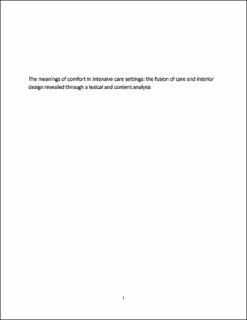| dc.contributor.author | Olausson, Sepideh | |
| dc.contributor.author | Isabell, Fridh | |
| dc.contributor.author | Lindahl, Berit Kristina | |
| dc.contributor.author | Torkildsby, Anne Britt | |
| dc.date.accessioned | 2020-04-06T16:47:25Z | |
| dc.date.available | 2020-04-06T16:47:25Z | |
| dc.date.created | 2019-06-01T10:19:57Z | |
| dc.date.issued | 2019 | |
| dc.identifier.citation | Critical Care Nursing Quarterly. 2019, 42 (3), 329-341. | en_US |
| dc.identifier.issn | 0887-9303 | |
| dc.identifier.uri | https://hdl.handle.net/11250/2650539 | |
| dc.description.abstract | Providing comfort in an intensive care unit (ICU) setting is often related to pain relief and end-of-life care; environmental factors are often neglected, despite the major role of the environment on the patients’ well-being and comfort. The aim of this article was to explore the meanings of comfort from a theoretical and empirical perspective to increase the understanding of what comfort means in ICU settings. A lexical analysis and serials of workshops were performed, and data were analyzed using a qualitative content analysis. The findings from the theoretical analysis show that comfort has a broad range of synonyms related to both subjective experiences and objective and physical qualities. The findings from the empirical part reveal 4 themes: comfort in relation to nature, comfort in relation to situation and people, comfort in relation to place, and comfort in relation to objects and material. Materiality, functionality, memory, culture, and history stipulate comfort. It is challenging to discern what comfort is when it comes to function and emotions. We also found that comfort is closely linked to nature and well-being. | en_US |
| dc.description.abstract | The Meaning of Comfort in the Intensive Care Unit | en_US |
| dc.language.iso | eng | en_US |
| dc.publisher | Lippincott, Williams & Wilkins | en_US |
| dc.relation.uri | https://www.researchgate.net/publication/333375397_The_Meaning_of_Comfort_in_the_Intensive_Care_Unit | |
| dc.subject | Wellbeing | en_US |
| dc.subject | Design for Wellbeing | en_US |
| dc.title | The Meaning of Comfort in the Intensive Care Unit | en_US |
| dc.type | Peer reviewed | en_US |
| dc.type | Journal article | en_US |
| dc.description.version | acceptedVersion | en_US |
| dc.subject.nsi | VDP::Helsefag: 800 | en_US |
| dc.subject.nsi | VDP::Health sciences: 800 | en_US |
| dc.source.pagenumber | 329-341 | en_US |
| dc.source.volume | 42 | en_US |
| dc.source.journal | Critical Care Nursing Quarterly | en_US |
| dc.source.issue | 3 | en_US |
| dc.identifier.doi | 10.1097/CNQ.0000000000000268 | |
| dc.identifier.cristin | 1702026 | |
| dc.relation.project | Vetenskapsrådet: Vetenskapsrådet | en_US |
| dc.description.localcode | © 2019. This is the authors' accepted and refereed manuscript to the chapter. Locked until 31.9.2020 due to copyright restrictions. The final authenticated version is available online at: http://dx.doi.org/10.1097/CNQ.0000000000000268 | en_US |
| cristin.unitcode | 194,65,80,0 | |
| cristin.unitcode | 194,64,94,0 | |
| cristin.unitname | Institutt for helsevitenskap Ålesund | |
| cristin.unitname | Institutt for vareproduksjon og byggteknikk | |
| cristin.ispublished | true | |
| cristin.fulltext | original | |
| cristin.qualitycode | 1 | |
